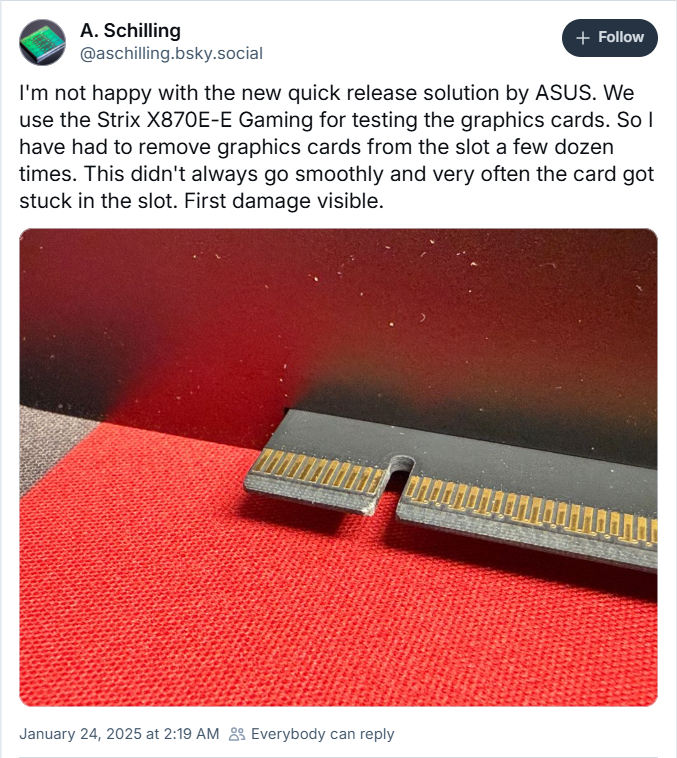Getting a graphics card in and out of a motherboard can be a hassle, especially now that they’re the approximate size, shape, and weight of a cinderblock. Asus tried to make things easier with its Q-Release system on 800-series motherboards, but it’s proving problematic — apparently, it’s scratching cards as they go in and out of the PCIe slot.
That’s according to Andreas Schilling of German tech site HardwareLuxx, who shared an image of a damaged graphics card on BlueSky this morning. Schilling says the ROG Strix X870E-E, which uses the Q-Release Slim attachment system, damaged an RTX 5090 card after multiple insertions and a few instances of sticking while testing. The photo shows a visible chip taken out of the card’s connector.

Bluesky
Asus introduced this version of the Q-Release system last year, an update to the original Q-Release from 2021.
But the Q-Release Slim found on high-end 2024 motherboards is more complex, physically gripping the card’s connection area and releasing it without any buttons, only with specific pressure from the side of the card facing the rear of the case. If you try to pull the card out from the middle or the rear, it won’t work. Here’s an example of it working… uh, sort of:
At least, that’s the idea. Schilling alleges that the system is a lot more finicky in practice, making it harder to get a card out than intended. And of course the damage in the photo will cause any PC builder to wince, whether or not they see it on a $2,000 card. The damage appears to be cosmetic… but pressure on that same spot could be a lot worse, as there’s less than an inch of PCB on that tab.
It’s worth noting that hardware reviewers are harder on these delicate components than end users, as a matter of course. While I might install a card three or four times over its lifetime with system upgrades and maintenance, a reviewer like Adam or Brad could perform the same number of actions on a single card or motherboard in just one day.
Schilling said that this particular slot had cards in and out of it “a few dozen times” on the test motherboard. Uniko’s Hardware (via Tom’s Hardware) showed a Bilibili user photo with a Q-Release Slim retention peg on the PCIe slot with visible damage after 60 actuations.
These examples of visible damage are relatively limited, but PCWorld’s Adam Patrick Murray agrees that Q-Release Slim has some issues. “Ever since I first started building PCs, I’ve learned to never yank on anything in that slot,” he told me in our company chat. “Now Asus is asking me to go against everything in my body to yank on it? No thanks. I’ve been yanking on it since CES and it NEVER feels okay.”
I don’t think this is something a regular user needs to be imminently scared of. Even the few examples that have visible damage aren’t actually affecting the pins. And, again, what we’re seeing is for usage that’s far beyond any standard PC builder. That said, if something DID happen to an expensive graphics card or motherboard, I can imagine it would be a huge headache if two different manufacturers started pointing fingers at each other during the RMA process.
Login to add comment
Other posts in this group

As promised, the U.S. retail prices of several key Philips Hue produc

Whether you’re a parent who wants to keep an eye on your kids even af

Between email, calls, texts, and now an unending torrent of AI slop,

Google has released an emergency update for Chrome, fixing a vulnerab

Sony makes gaming monitors. I know, it’s kind of a shock, right? I ha


